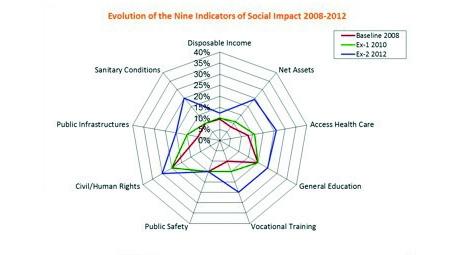When can a philanthropic action by the foundation be defined as effective?
«Each Foundation has different mission which is defined in its statutes. The goals derived from this mission usually determines the target population of the projects carried out by the foundation and the problems it tries to tackle. For instance, it can refer to the care of special needs children, to providing underprivileged children with access to education, or to fostering micro-entrepreneurs and so on. A foundation is efficient when it achieves its goals while concurrently optimizing the scarce resources at its disposal. Both effectiveness and efficiency have to go hand in hand».
Why is it important to measure the social impact of the foundation?
«Most of the institutions working in the social sector are able to measure the results of their activities. Through this information, we understand what these institutions are doing. For instance, we can get to know the number of children attending an educational program, or the number of young people who receive a scholarship.
While this data is important, it does not tell us whether the living conditions of the beneficiaries is or has improved. However, social impact is about knowing how and in what measure have the living conditions been affected by the interventions (activities, projects) carried out by the foundations. That is why the only way of knowing whether a foundation is achieving its goals is through measuring the social impact it is creating. Let us say for example, if you want to begin the construction of a school in a developing country, you will need to build it, engage teachers and enroll a certain number of students. All these are the results of your project. However, it does not tell you whether the education provided is of good quality and how well students perform after having completed school.
The same applies to a project aimed at empowering micro-entrepreneurs. The number of micro-entrepreneurs supported, the number of micro credits given and so on, does not tell you whether the living conditions of the beneficiaries is improving. This data only explains the results of the project. When the foundations remain at the results level, they do not know whether they are creating a positive social impact or not. And this is what really matters!».
Which factors are important, and why?
«Actually, all factors that may affect the living conditions of a person are important. In this sense, when designing an evaluation to assess the social impact of a project, we cannot only take into account the targeted goals (education, income generation, poverty alleviation, etc.), but we also have to consider the beneficiary as a person. Factors affecting human well-being always have four elements: the tangible and the intangible on one side, and the individual and the collective on the other side. Most social projects affect the person within those four elements. Maybe in an unintended way, but they affect them. If, when measuring the social impact, we do not assess what is happening to the person as a whole – if do not have a 360o approach- we will be missing some key aspects of the impact of the project».
You have developed a model for measuring social impact: can you explain to us how it works?
«My long-term experience in the social sector (more than 30 years) has helped me develop an impact measurement model which can be applied to a large variety of social projects. This is called the “Socio-Economic Welfare Index –SEWI”. It is based on the four elements mentioned before. The living conditions of a person are determined by all the resources that he or she has at a certain period.
Before starting a social intervention, we establish the baseline data by surveying those who will benefit from the project. To do that, we look for definite indicators, which will cover the four elements and, therefore, will give us a precise picture of the living condition of the future beneficiaries of the project.
After a certain time (which depends on the nature of the project itself), we use the same indicators to assess the situation of the beneficiaries after the project has ended. This is called the ex-post evaluations. The difference in the data obtained from these assessments gives us the changes that the project has effected in the lives of the beneficiaries. This difference is what is termed social impact. Below is a chart, which summarizes what I have said.
This chart shows the analysis of nine indicators chosen to measure the impact of a project designed to empower micro-entrepreneurs. We can observe that eight of the indicators have shown a marked improvement. Some of them are in areas that the project was directly targeting (income, assets and education), while others are not (access to healthcare, sanitary conditions, etc.). It demonstrates that, as already said, usually impact goes beyond targeted areas. This chart reflects this».
What are the benefits to a foundation in applying such a model?
«The benefits of incorporating and conducting impact evaluations for t projects are many. Maybe the most significant is the change in mentality that it provokes in the management of a non-profit. It leads them to think in terms of impact (outcome), and not in terms of results (output). On top of that, impact measurement becomes a very valuable management tool. Coming back to the previous chart, if you were looking to decide on the areas in which to start new projects targeting the same beneficiaries, the previous analysis gives you a clear answer: income generation and public safety, because these are the areas where new interventions could achieve a greater impact for the beneficiaries.
Does it work just as well for small/medium foundations?
«Yes, indeed. The size of a foundation is not the decisive criteria on whether to conduct impact measurement or not. The most crucial is factor is whether the foundation wants to focus on results or on impact.
Nevertheless, I have to advise that not all projects should undergo an impact evaluation. One determining factor is the size of the project itself. For small projects, or for “one shot” projects, I do not recommend making an impact evaluation. But for pilot projects, or for projects that will be ongoing and supported for many years, impact evaluation should be a must. The knowledge acquired through impact evaluations compensates by far the efforts required to carry it out. My experience shows, that after an impact evaluation, foundations often redesign their strategy, leading to a more effective use of their funds, and hence resulting in a higher social impact».
From a cost point of view, what percentage of the overall investment should the cost of measurement be?
«Although there is no general rule, I consider that for medium-sized projects, the costs of the impact measurement should not be greater than 5 to 7% of the total investment into the project. In the case of pilot projects, however, there may be a higher rate due to the fact that we want to know whether the project should be scaled up or not».















